The secure supply of electricity is crucial for the reliability of systems, data centers, and buildings. A failure is not necessarily caused by the user or the infeed. The path from the generator to the system harbors risks that should be kept in mind for a secure energy supply. Short circuit protection is critical for system availability even after the actual event. Standard-compliant measures for cable installation offer more security.
An electrical short circuit leads to a massive increase in current flow through low and medium-voltage cables in just a few milliseconds. The amperage can be up to 200,000A during such events. The increased current flow and the resulting magnetic field around the cable create dynamic forces through the interaction of 50 Hz. As a result, the cables are made to vibrate. In the worst case of a three-phase short circuit, the magnetic field-induced impact forces between the cables can be up to 45,000 Newtons and develop within 1/100 of a second. Significant damage can occur before the circuit breakers can trip on the short circuit. As a result, cable retention is critical to protecting personnel and infrastructure, as well as reducing downtime.
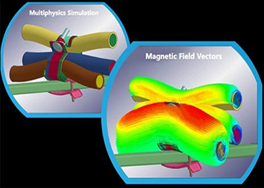
The simulation shows the development of forces in the event of a short circuit; Panduit supplies suitable cable cleat solutions and ideally prepares for the test according to IEC 61914: 2015.
These dynamic forces are absorbed by the cable cleats and the associated cable support system. The cable cleats, which are attached to the support system, prevent individual cables from being torn loose by the vibration and damage to system parts, and the electrical installation. Nevertheless, in new or existing systems, the apparently fast, but poor, way of fastening cables is unfortunately being sought. You don't want to imagine the worst-case scenarios. It is relatively easy to use a professional and safe installation solution.
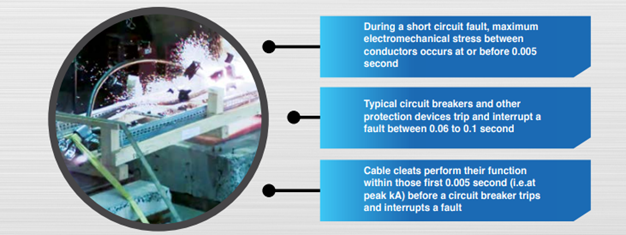
Live cables can be laid and secured in different ways in plants, production facilities, buildings, or data centers. As a structural mechanical solution, e.g. the new cable cleats from Panduit protect against the effects of short circuits and thus significantly increase the system safety. This topic has been gaining in importance since the international standard IEC 61914: 2015 (German version DIN EN 61914: 2016) for cable clamps for electrical installations was implemented. The standard describes the necessary test set up very precisely, which simulates the resistance to electromechanical forces and how the forces on cables and cable clamps can be calculated based on this. Panduit's research and development department use a modern simulation program to determine how the electromagnetic forces develop in the event of a short circuit and which material composition of the cable cleats is suitable. The virtual observation ideally prepares for the test according to IEC 61914: 2015. Only after being simulated on the computer are the components subjected to real short-circuit tests in a certified laboratory to confirm that they meet this standard. Panduit's research and development engineers use modern simulation software to model the dynamic 3-phase AC short-circuit test. The virtual experiment takes place over a period of a tenth of a second (see IEC 61914: 2015). The simulation makes it clear that components develop speeds of more than 50m/s, materials can deform significantly and, catastrophic failures and damage can ensue. The results of the simulation development are:
- Adaptation of the stiffness, yield strength, and mass of solid copper conductors for use under the possible temperature conditions of the cables
- Development of material models with high strain rates for each component
- Inclusion of the electromagnetic simulation
- Development of a mathematical model with 30 variables, with which the algorithm for the different coefficients is determined
- Development of criteria for the wear of elements to enable the simulation of physical failure
- Successful verification in early tests
 Overview of short-circuit tests, testing according to IEC 61914: 2015 in a KEMA test environment; independent, ISO 17025 certified test, inspection, and certification services (IEEE, IEC, UL, and ANSI) for electrical systems.
Overview of short-circuit tests, testing according to IEC 61914: 2015 in a KEMA test environment; independent, ISO 17025 certified test, inspection, and certification services (IEEE, IEC, UL, and ANSI) for electrical systems.
The new product line of cable cleats is certified in test labs by the testing institute KEMA Labs. The peak values of the short-circuit current are very close to those of the simulation. In addition, the following areas are included in the real test:
- Temperature ranges from -60 ̊C to +120 ̊C
- Resistance to flame spread analogous to UL 94
- Checking the lateral load at the maximum temperature
- Test of the axial load at the maximum temperature
- Impact resistance at a minimum temperature
- Corrosion and UV resistance
- Resistance to electromechanical forces
-
Overall, Panduit's R&D department was able to determine the variables involved in the three-phase short-circuit faster and more efficiently. In repeated simulations, design changes were verified, and peak current certification levels were determined. In summary, the prototype and test cycle could be reduced significantly. The simulation and the real tests reinforce how critical short-circuit-proof fastening of current-carrying low-voltage and medium-voltage cable is. The IEC defines the cable cleat as a component that secures cables when they are attached at fixed intervals along the length of the cable. The aim is to absorb static and dynamic forces and to hold the power lines firmly in place. In addition, the lines should remain undamaged in the event of a short circuit so that the entire system can be switched on again and continue to be used.
The IEC standard 61914: 2015 plays a special role in the development of Panduit cable cleats. The standard, with the addition "2015", is the current, most comprehensive, and globally recognized requirement for testing cable cleats. The American, family-owned company, founded in 1955, was the first to meet these high requirements in such a way that the cable cleats can safely withstand enormous mechanical forces in the event of a short circuit. In detail: The greatest load in short circuits occurs up to 0.005 seconds before circuit breakers and other protective devices are triggered. The new cable cleats fix bundles of cables and ensure that cables remain securely attached, and in place, in the event of a short circuit. This provides the best possible protection for the work environment, including equipment and employees, and prevents downtime.
Learn why cable cleats are vital to project major infrastructure projects, here.
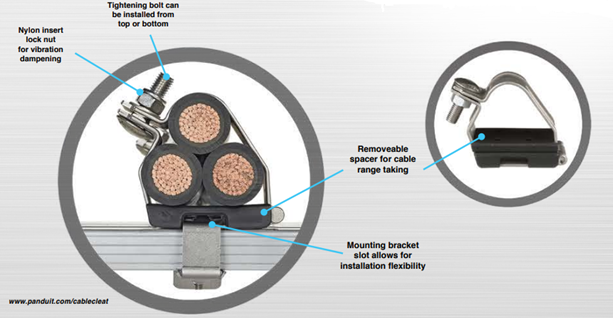
Panduit cable cleats, manufactured in accordance with IEC 61914: 2015 (German version DIN EN 61914: 2016), offer protection and safety for people and systems.
The new cable cleats from Panduit vary in size, design, and materials and are suitable for a wide variety of applications in process engineering systems, information technology, and industrial production. There is a choice of materials for the various applications, aluminum, plastic, and corrosion-resistant, dual-certified stainless steel 316 / 316L. Stainless steel cable cleats have folded and rounded edges so that they do not damage the cables. The buckle has its own cable holder and can accommodate cables in four-leaf and clover-leaf formations as well as multi-core cables. Once the cables are in place, the cable cleat can be attached using a mounting bracket that is unique in the industry. The bracket can be tensioned and cut to length with a hand-operated ratchet installation tool or a tool for tightening a tensioning screw. The ties are often used in conjunction with a damping sleeve inserted between the tie and the cable to provide additional protection. A plastic buckle is available for stainless steel cable ties as well as various mounting brackets. As an example, stainless steel cable cleats are available for cable diameters from 12 to 86 mm in widths from 12.7 to 19.1 mm for short-circuit currents from 45 to 188 kA. Of course, tools for professional and quick installation are also available.
Benefits of cable cleats in accordance with IEC 61914: 2015:
- User-friendly and professional cable installation
- Risk reduction in the event of a short circuit by absorbing static, mechanical, and dynamic forces
- Protection of people and system components
- Securing the energy supply
-

For more information, visit: https://solutions.itrident.com/panduit-cable-cleat-solutions
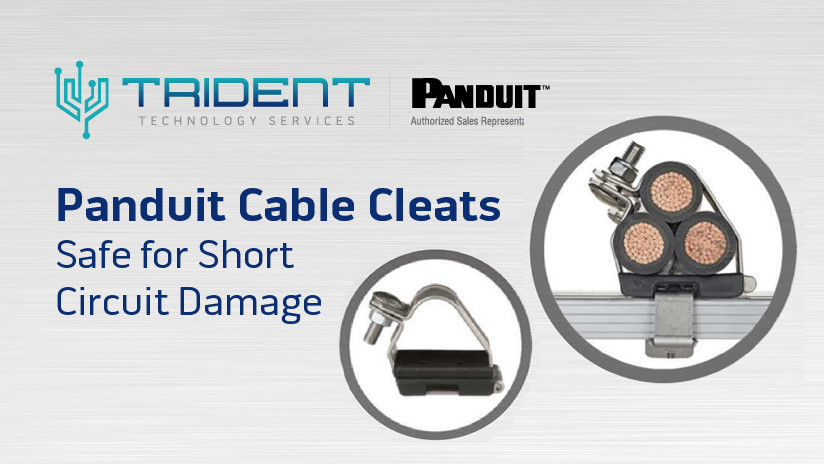














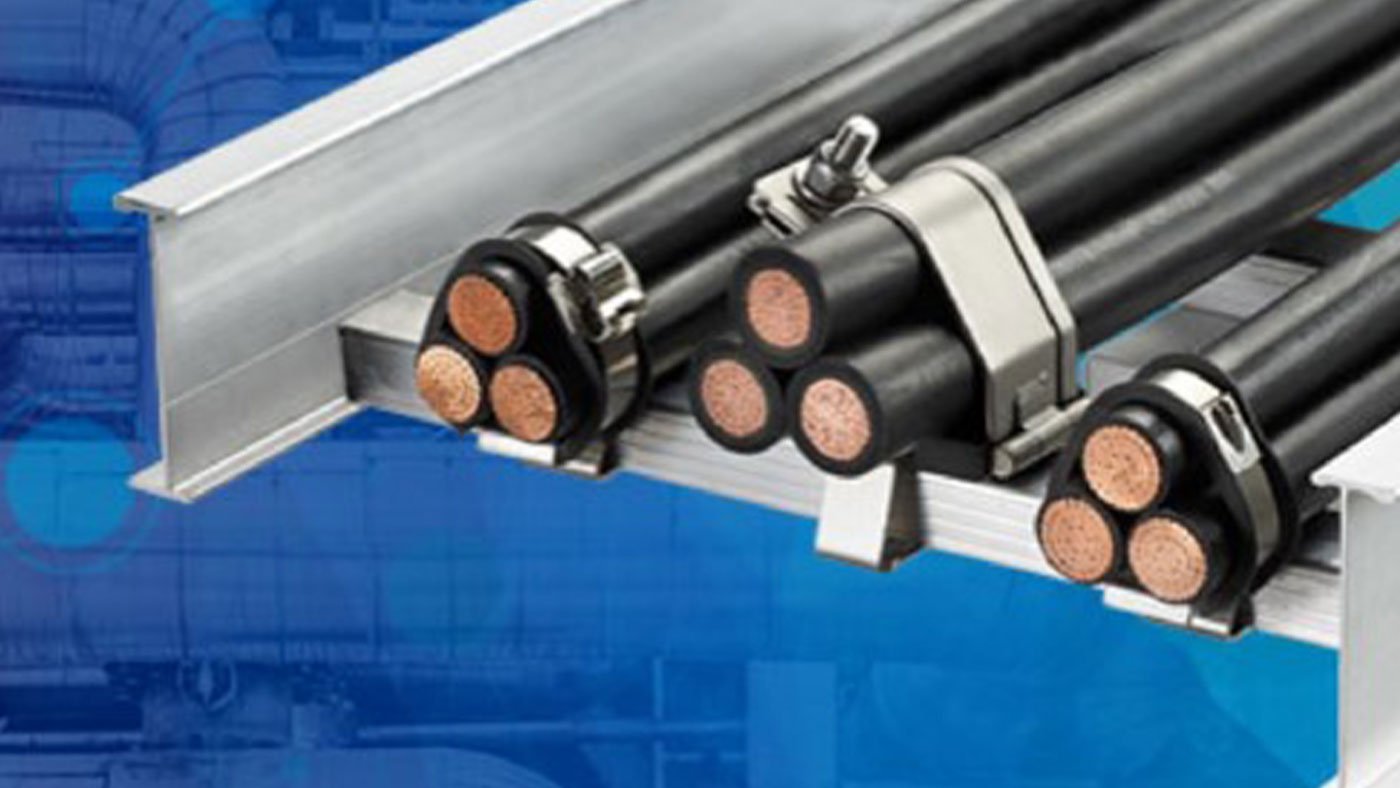

















 Back
Back




